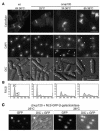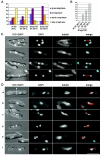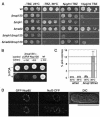The fission yeast Nup107-120 complex functionally interacts with the small GTPase Ran/Spi1 and is required for mRNA export, nuclear pore distribution, and proper cell division
- PMID: 15226438
- PMCID: PMC434257
- DOI: 10.1128/MCB.24.14.6379-6392.2004
The fission yeast Nup107-120 complex functionally interacts with the small GTPase Ran/Spi1 and is required for mRNA export, nuclear pore distribution, and proper cell division
Abstract
We have characterized Schizosaccharomyces pombe open reading frames encoding potential orthologues of constituents of the evolutionarily conserved Saccharomyces cerevisiae Nup84 vertebrate Nup107-160 nuclear pore subcomplex, namely Nup133a, Nup133b, Nup120, Nup107, Nup85, and Seh1. In spite of rather weak sequence conservation, in vivo analyses demonstrated that these S. pombe proteins are localized at the nuclear envelope. Biochemical data confirmed the organization of these nucleoporins within conserved complexes. Although examination of the S. cerevisiae and S. pombe deletion mutants revealed different viability phenotypes, functional studies indicated that the involvement of this complex in nuclear pore distribution and mRNA export has been conserved between these highly divergent yeasts. Unexpectedly, microscopic analyses of some of the S. pombe mutants revealed cell division defects at the restrictive temperature (abnormal septa and mitotic spindles and chromosome missegregation) that were reminiscent of defects occurring in several S. pombe GTPase Ran (Ran(Sp))/Spi1 cycle mutants. Furthermore, deletion of nup120 moderately altered the nuclear location of Ran(Sp)/Spi1, whereas overexpression of a nonfunctional Ran(Sp)/Spi1-GFP allele was specifically toxic in the Deltanup120 and Deltanup133b mutant strains, indicating a functional and genetic link between constituents of the S. pombe Nup107-120 complex and of the Ran(Sp)/Spi1 pathway.
Figures










References
-
- Allen, N. P. C., S. S. Patel, L. Huang, R. J. Chalkley, A. Burlingame, M. Lutzmann, E. C. Hurt, and M. Rexach. 2002. Deciphering networks of protein interactions at the nuclear pore complex. Mol. Cell. Proteomics 1:930-946. - PubMed
-
- Arnaoutov, A., and M. Dasso. 2003. The Ran GTPase regulates kinetochore function. Dev. Cell 5:99-111. - PubMed
-
- Azad, A. K., T. Ideue, Y. Ohshima, and T. Tani. 2003. A mutation in the gene involved in sister chromatid separation causes a defect in nuclear mRNA export in fission yeast. Biochem. Biophys. Res. Commun. 310:176-181. - PubMed
Publication types
MeSH terms
Substances
Grants and funding
LinkOut - more resources
Full Text Sources
Molecular Biology Databases
Miscellaneous
